跨文化交际经历 英语
- 格式:doc
- 大小:38.00 KB
- 文档页数:2
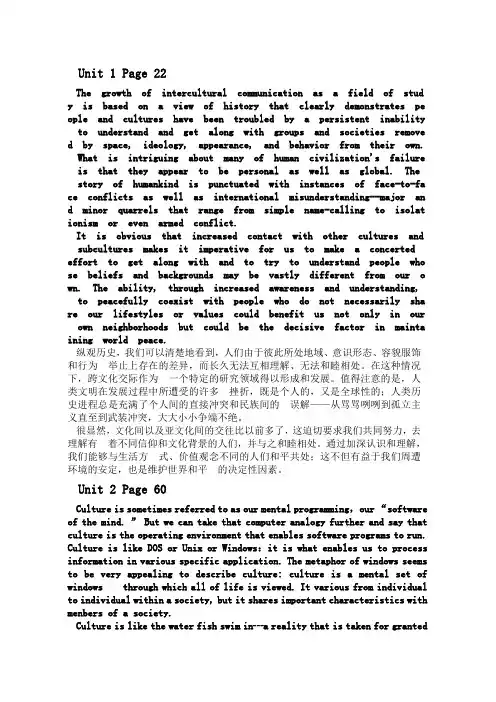
Unit 1 Page 22The growth of intercultural communication as a field of stud y is based on a view of history that clearly demonstrates pe ople and cultures have been troubled by a persistent inability to understand and get along with groups and societies remove d by space, ideology, appearance, and behavior from their own.What is intriguing about many of human civilization's failure is that they appear to be personal as well as global. The story of humankind is punctuated with instances of face-to-fa ce conflicts as well as international misunderstanding--major an d minor quarrels that range from simple name-calling to isolat ionism or even armed conflict.It is obvious that increased contact with other cultures and subcultures makes it imperative for us to make a concerted effort to get along with and to try to understand people who se beliefs and backgrounds may be vastly different from our o wn. The ability, through increased awareness and understanding, to peacefully coexist with people who do not necessarily sha re our lifestyles or values could benefit us not only in our own neighborhoods but could be the decisive factor in mainta ining world peace.纵观历史,我们可以清楚地看到,人们由于彼此所处地域、意识形态、容貌服饰和行为举止上存在的差异,而长久无法互相理解、无法和睦相处。
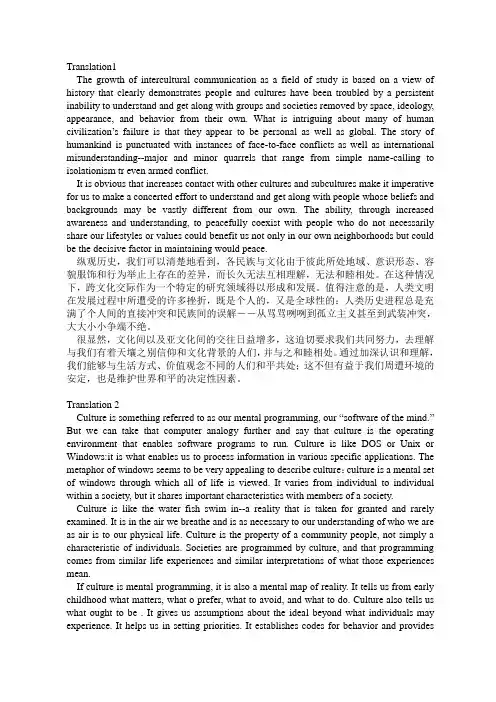
Translation1The growth of intercultural communication as a field of study is based on a view of history that clearly demonstrates people and cultures have been troubled by a persistent inability to understand and get along with groups and societies removed by space, ideology, appearance, and behavior from their own. What is intriguing about many of human civilization’s failure is that they appear to be personal as well as global. The story of humankind is punctuated with instances of face-to-face conflicts as well as international misunderstanding--major and minor quarrels that range from simple name-calling to isolationism tr even armed conflict.It is obvious that increases contact with other cultures and subcultures make it imperative for us to make a concerted effort to understand and get along with people whose beliefs and backgrounds may be vastly different from our own. The ability, through increased awareness and understanding, to peacefully coexist with people who do not necessarily share our lifestyles or values could benefit us not only in our own neighborhoods but could be the decisive factor in maintaining would peace.纵观历史,我们可以清楚地看到,各民族与文化由于彼此所处地域、意识形态、容貌服饰和行为举止上存在的差异,而长久无法互相理解,无法和睦相处。
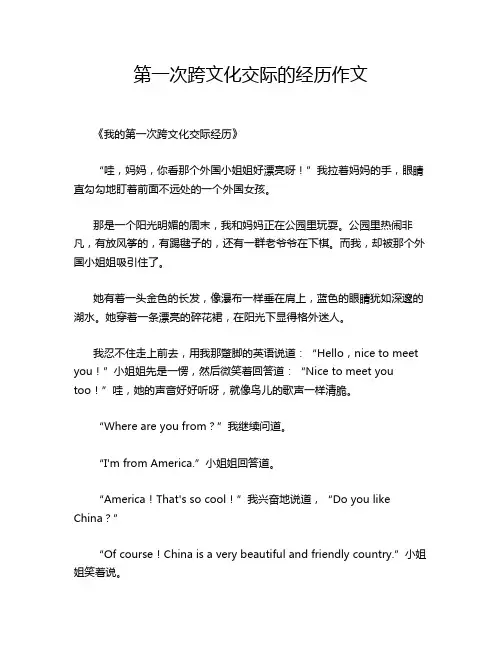
第一次跨文化交际的经历作文《我的第一次跨文化交际经历》“哇,妈妈,你看那个外国小姐姐好漂亮呀!”我拉着妈妈的手,眼睛直勾勾地盯着前面不远处的一个外国女孩。
那是一个阳光明媚的周末,我和妈妈正在公园里玩耍。
公园里热闹非凡,有放风筝的,有踢毽子的,还有一群老爷爷在下棋。
而我,却被那个外国小姐姐吸引住了。
她有着一头金色的长发,像瀑布一样垂在肩上,蓝色的眼睛犹如深邃的湖水。
她穿着一条漂亮的碎花裙,在阳光下显得格外迷人。
我忍不住走上前去,用我那蹩脚的英语说道:“Hello,nice to meet you!”小姐姐先是一愣,然后微笑着回答道:“Nice to meet you too!”哇,她的声音好好听呀,就像鸟儿的歌声一样清脆。
“Where are you from?”我继续问道。
“I'm from America.”小姐姐回答道。
“America!That's so cool!”我兴奋地说道,“Do you like China?”“Of course!China is a very beautiful and friendly country.”小姐姐笑着说。
我们就这样你一言我一语地聊了起来,虽然我的英语不是很好,但小姐姐一直很耐心地听我说话,还时不时地纠正我的发音。
妈妈在一旁看着我们,脸上露出了欣慰的笑容。
她走过来对我说:“宝贝,你真棒!能和外国小姐姐聊得这么开心。
”“嘻嘻,妈妈,我觉得和她聊天好有意思呀!”我笑着说。
这时,小姐姐从包里拿出了一块巧克力,递给我说:“Here you are,a little gift for you.”“Thank you so much!”我高兴地接过巧克力,心里像吃了蜜一样甜。
时间过得真快呀,转眼间太阳就要落山了。
小姐姐说她要回家了,我们互相道别。
“Bye,hope to see you again!”我挥着手说道。
“Bye,have a nice day!”小姐姐也挥着手说道。
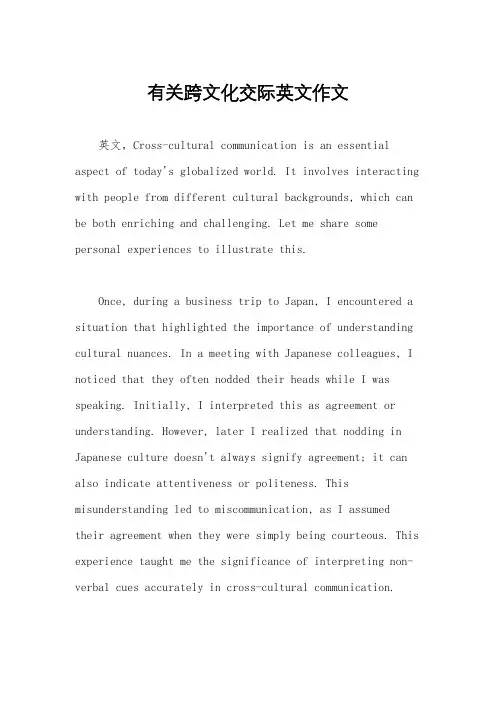
有关跨文化交际英文作文英文,Cross-cultural communication is an essential aspect of today's globalized world. It involves interacting with people from different cultural backgrounds, which can be both enriching and challenging. Let me share some personal experiences to illustrate this.Once, during a business trip to Japan, I encountered a situation that highlighted the importance of understanding cultural nuances. In a meeting with Japanese colleagues, I noticed that they often nodded their heads while I was speaking. Initially, I interpreted this as agreement or understanding. However, later I realized that nodding in Japanese culture doesn't always signify agreement; it can also indicate attentiveness or politeness. This misunderstanding led to miscommunication, as I assumedtheir agreement when they were simply being courteous. This experience taught me the significance of interpreting non-verbal cues accurately in cross-cultural communication.Another instance occurred during a cultural exchange program in Brazil. While conversing with locals, I noticed they often stood close to me and used expressive gestures. At first, I felt uncomfortable with the proximity, as personal space boundaries vary across cultures. However, I gradually adapted and even found it refreshing to engage in such close, animated conversations. This experience taught me the importance of respecting and adapting to different cultural norms, even if they initially seem unfamiliar.中文,跨文化交际在今天全球化的世界中至关重要。
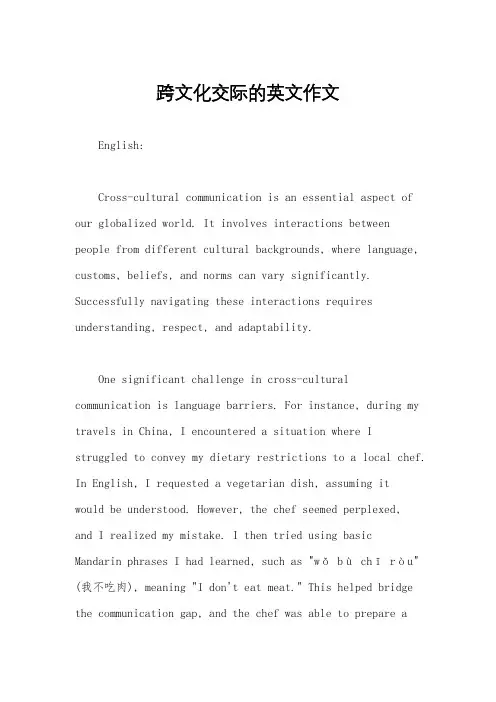
跨文化交际的英文作文English:Cross-cultural communication is an essential aspect of our globalized world. It involves interactions between people from different cultural backgrounds, where language, customs, beliefs, and norms can vary significantly. Successfully navigating these interactions requires understanding, respect, and adaptability.One significant challenge in cross-cultural communication is language barriers. For instance, during my travels in China, I encountered a situation where Istruggled to convey my dietary restrictions to a local chef. In English, I requested a vegetarian dish, assuming itwould be understood. However, the chef seemed perplexed,and I realized my mistake. I then tried using basic Mandarin phrases I had learned, such as "wǒ bù chī ròu" (我不吃肉), meaning "I don't eat meat." This helped bridge the communication gap, and the chef was able to prepare asuitable meal.Another aspect to consider is non-verbal communication. In many cultures, gestures, facial expressions, and body language convey meanings as much as words do. For example, a firm handshake is often seen as a sign of confidence and respect in Western cultures. However, in some Asian cultures, a softer handshake may be more appropriate, as a firm grip can be perceived as aggressive. Understanding these nuances is crucial for building rapport and avoiding misunderstandings.Moreover, cultural differences in communication styles can lead to misunderstandings. For instance, in some cultures, direct communication is valued, while in others, indirect communication is preferred to maintain harmony. During a business negotiation in Japan, I found that my straightforward approach was met with silence and nods, which I initially interpreted as agreement. However, upon reflection, I realized that my Japanese counterparts were being polite and non-confrontational, and their silence indicated they were considering my proposal rather thanagreeing outright.In conclusion, effective cross-cultural communication requires patience, empathy, and an open mind. Byrecognizing and respecting cultural differences in language, non-verbal cues, and communication styles, we can foster mutual understanding and build stronger relationshipsacross borders.中文:跨文化交际是我们全球化世界中至关重要的一部分。
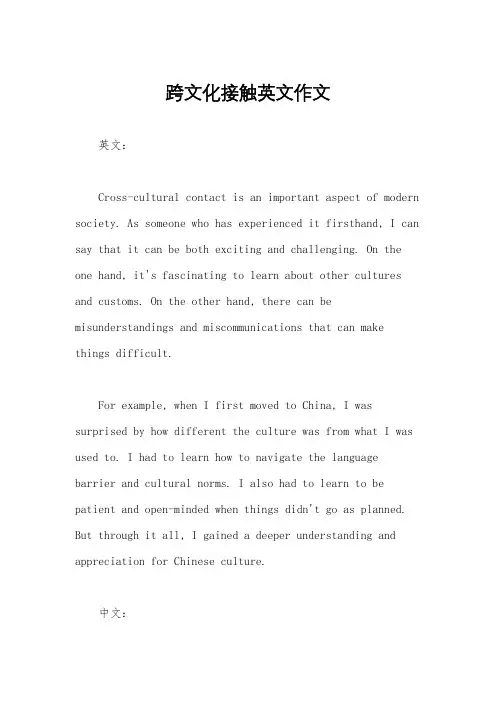
跨文化接触英文作文英文:Cross-cultural contact is an important aspect of modern society. As someone who has experienced it firsthand, I can say that it can be both exciting and challenging. On the one hand, it's fascinating to learn about other cultures and customs. On the other hand, there can be misunderstandings and miscommunications that can make things difficult.For example, when I first moved to China, I was surprised by how different the culture was from what I was used to. I had to learn how to navigate the languagebarrier and cultural norms. I also had to learn to be patient and open-minded when things didn't go as planned. But through it all, I gained a deeper understanding and appreciation for Chinese culture.中文:跨文化接触是现代社会的一个重要方面。
作为亲身经历过的人,我可以说,它既令人兴奋又具有挑战性。
一方面,了解其他文化和习俗是很有趣的。
另一方面,可能会有误解和沟通不畅的情况,这可能会使事情变得困难。
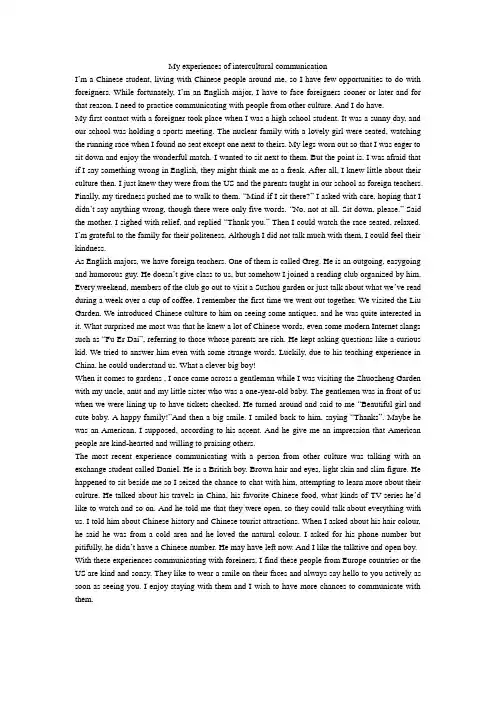
My experiences of intercultural communicationI’m a Chinese student, living with Chinese people around me, so I have few opportunities to do with foreigners. While fortunately, I’m an English major, I have to face foreigners sooner or later and for that reason, I need to practice communicating with people from other culture. And I do have.My first contact with a foreigner took place when I was a high school student. It was a sunny day, and our school was holding a sports meeting. The nuclear family with a lovely girl were seated, watching the running race when I found no seat except one next to theirs. My legs worn out so that I was eager to sit down and enjoy the wonderful match. I wanted to sit next to them. But the point is, I was afraid that if I say something wrong in English, they might think me as a freak. After all, I knew little about their culture then. I just knew they were from the US and the parents taught in our school as foreign teachers. Finally, my tiredness pushed me to walk to them. “Mind if I sit there?” I asked with care, hoping that I did n’t say anything wrong, though there were only five words. “No, not at all. Sit down, please.” Said the mother. I sighed with relief, and replied “Thank you.” Then I could watch the race seated, relaxed. I’m grateful to the family for their politeness. Although I did not talk much with them, I could feel their kindness.As English majors, we have foreign teachers. One of them is called Greg. He is an outgoing, easygoing and humorous guy. He doesn’t give class to us, but somehow I joined a reading club organized by him. Every weekend, members of the club go out to visit a Suzhou garden or just talk about what we’ve read during a week over a cup of coffee. I remember the first time we went out together. We v isited the Liu Garden. We introduced Chinese culture to him on seeing some antiques, and he was quite interested in it. What surprised me most was that he knew a lot of Chinese words, even some modern Internet slangs such as “Fu Er Dai”, referring to those whose parents are rich. He kept asking questions like a curious kid. We tried to answer him even with some strange words. Luckily, due to his teaching experience in China, he could understand us. What a clever big boy!When it comes to gardens , I once came across a gentleman while I was visiting the Zhuozheng Garden with my uncle, anut and my little sister who was a one-year-old baby. The gentlemen was in front of us when we were lining up to have tickets checked. He turned around and said to me “Beautiful girl and cute baby. A happy family!”And then a big s mile. I s miled back to him, saying “Thanks”. Maybe he was an American, I supposed, according to his accent. And he give me an impression that American people are kind-hearted and willing to praising others.The most recent experience communicating with a person from other culture was talking with an exchange student called Daniel. He is a British boy. Brown hair and eyes, light skin and slim figure. He happened to sit beside me so I seized the chance to chat with him, attempting to learn more about their culture. He talked about his travels in China, his favorite Chinese food, what kinds of TV series he’d like to watch and so on. And he told me that they were open, so they could talk about everything with us. I told him about Chinese history and Chinese tourist attractions. When I asked about his hair colour, he said he was from a cold area and he loved the natural colour. I asked for his phone number but pitifully, he didn’t have a Chinese number. He may have left now. And I like the talktive and open boy. With these experiences communicating with foreiners, I find these people from Europe countries or the US are kind and sonsy. They like to wear a s mile on their faces and always say hello to you actively as soon as seeing you. I enjoy staying with them and I wish to have more chances to communicate with them.。
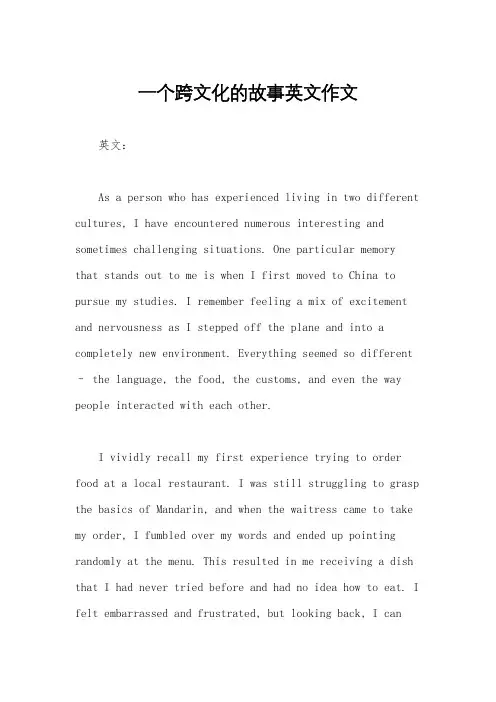
一个跨文化的故事英文作文英文:As a person who has experienced living in two different cultures, I have encountered numerous interesting and sometimes challenging situations. One particular memorythat stands out to me is when I first moved to China to pursue my studies. I remember feeling a mix of excitement and nervousness as I stepped off the plane and into a completely new environment. Everything seemed so different – the language, the food, the customs, and even the way people interacted with each other.I vividly recall my first experience trying to order food at a local restaurant. I was still struggling to grasp the basics of Mandarin, and when the waitress came to take my order, I fumbled over my words and ended up pointing randomly at the menu. This resulted in me receiving a dish that I had never tried before and had no idea how to eat. I felt embarrassed and frustrated, but looking back, I canlaugh at the situation and appreciate the learning experience it provided.Living in China also exposed me to various cultural practices and traditions that were unfamiliar to me. For example, I was invited to a traditional Chinese wedding,and I was amazed by the elaborate ceremonies and ritualsthat were part of the celebration. I also had theopportunity to participate in the Chinese New Year festivities, where I learned about the significance of red envelopes and the traditional lion dance. These experiences not only broadened my understanding of Chinese culture but also allowed me to form meaningful connections with thelocal community.中文:作为一个在两种不同文化中生活过的人,我遇到了许多有趣的,有时是具有挑战性的情况。
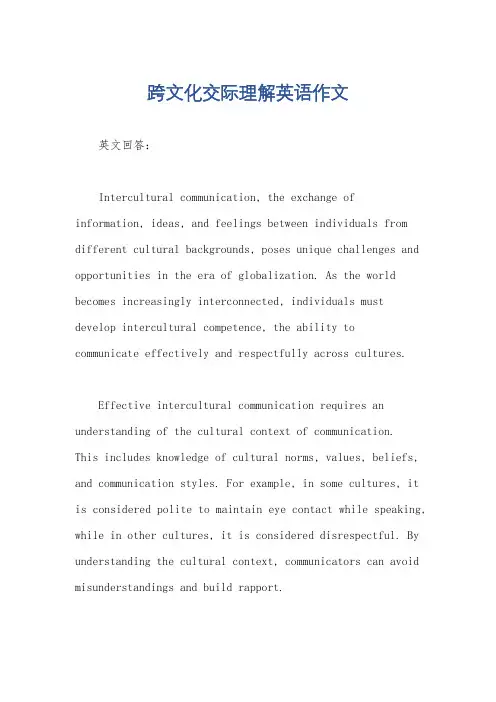
跨文化交际理解英语作文英文回答:Intercultural communication, the exchange of information, ideas, and feelings between individuals from different cultural backgrounds, poses unique challenges and opportunities in the era of globalization. As the world becomes increasingly interconnected, individuals must develop intercultural competence, the ability to communicate effectively and respectfully across cultures.Effective intercultural communication requires an understanding of the cultural context of communication.This includes knowledge of cultural norms, values, beliefs, and communication styles. For example, in some cultures, it is considered polite to maintain eye contact while speaking, while in other cultures, it is considered disrespectful. By understanding the cultural context, communicators can avoid misunderstandings and build rapport.In addition to cultural understanding, effective intercultural communication also requires empathy and flexibility. Empathy is the ability to understand and share the feelings of others. By showing empathy, communicators can build trust and create a cooperative atmosphere. Flexibility is the ability to adapt one's communication style to the needs of the situation. For example, in a formal setting, it might be appropriate to use a more formal communication style, while in a casual setting, a more informal style might be more appropriate.Finally, effective intercultural communication requires a willingness to learn and grow. Individuals should be open to new experiences and perspectives, and they should be willing to challenge their own assumptions. By embracing the principles of effective intercultural communication, individuals can build strong relationships, foster understanding, and create a more just and equitable world.中文回答:跨文化交际是不同文化背景的个人之间信息、思想和情感的交流,在全球化的时代里带来了独特的挑战和机遇。
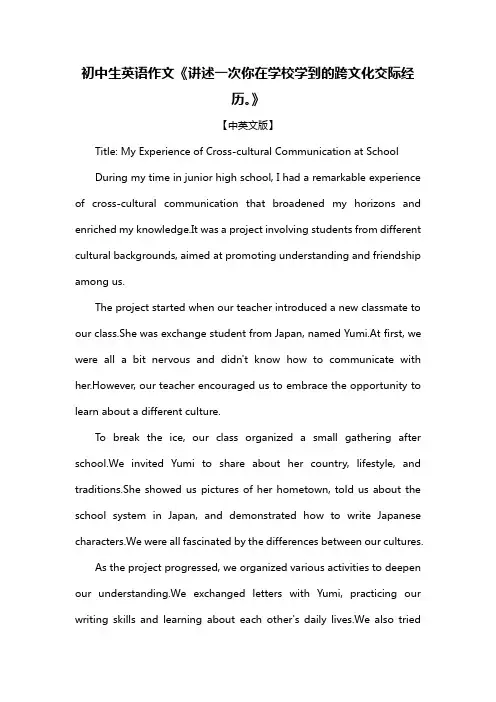
初中生英语作文《讲述一次你在学校学到的跨文化交际经历。
》【中英文版】Title: My Experience of Cross-cultural Communication at SchoolDuring my time in junior high school, I had a remarkable experience of cross-cultural communication that broadened my horizons and enriched my knowledge.It was a project involving students from different cultural backgrounds, aimed at promoting understanding and friendship among us.The project started when our teacher introduced a new classmate to our class.She was exchange student from Japan, named Yumi.At first, we were all a bit nervous and didn't know how to communicate with her.However, our teacher encouraged us to embrace the opportunity to learn about a different culture.To break the ice, our class organized a small gathering after school.We invited Yumi to share about her country, lifestyle, and traditions.She showed us pictures of her hometown, told us about the school system in Japan, and demonstrated how to write Japanese characters.We were all fascinated by the differences between our cultures.As the project progressed, we organized various activities to deepen our understanding.We exchanged letters with Yumi, practicing our writing skills and learning about each other's daily lives.We also triedtraditional Japanese cuisine, such as sushi and ramen, which was a unique and delicious experience.Through this project, I realized the importance of cultural diversity and the need for cross-cultural communication.I learned that despite our differences, we share many common interests and goals.Yumi's presence in our class helped us appreciate the value of tolerance and respect for different cultures.In conclusion, my experience of cross-cultural communication at school was truly memorable.It not only improved my language skills but also broadened my horizons.I am grateful for the opportunity to have learned from Yumi and my classmates, and I believe that this experience has prepared me for a future filled with diverse cultural encounters.。
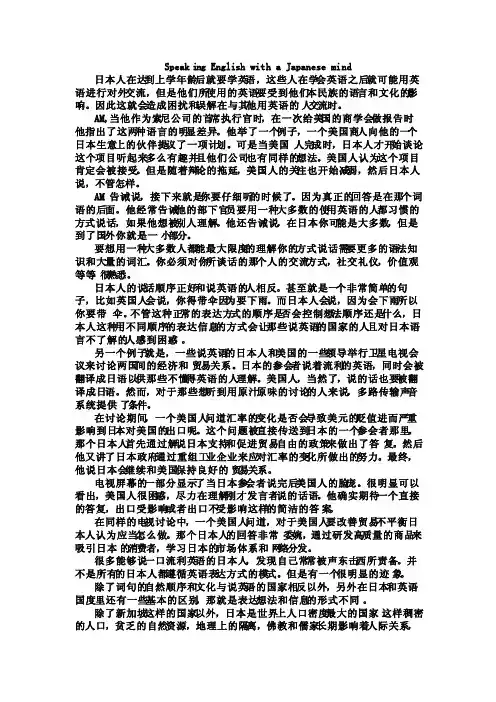
Speaki ng Englis h with a Japane se mind 日本人在达到上学年龄后就要学英语,这些人在学会英语之后就可能用英语进行对外交流,但是他们所使用的英语要受到他们本民族的语言和文化的影响。
因此这就会造成困扰和误解在与其他用英语的人交流时。
AM,当他作为索尼公司的首席执行官时,在一次给美国的商学会做报告时他指出了这两种语言的明显差异。
他举了一个例子,一个美国商人向他的一个日本生意上的伙伴提议了一项计划。
可是当美国人完成时,日本人才开始谈论这个项目听起来多么有趣并且他们公司也有同样的想法。
美国人认为这个项目肯定会被接受。
但是随着辩论的拖延,美国人的关注也开始减弱,然后日本人说,不管怎样。
AM告诫说,接下来就是你要仔细听的时候了。
因为真正的回答是在那个词语的后面。
他经常告诫他的部下官员要用一种大多数的使用英语的人都习惯的方式说话,如果他想被别人理解。
他还告诫说,在日本你可能是大多数,但是到了国外你就是一小部分。
要想用一种大多数人都能最大限度的理解你的方式说话需要更多的语法知识和大量的词汇。
你必须对你所谈话的那个人的交流方式,社交礼仪,价值观等等很熟悉。
日本人的说话顺序正好和说英语的人相反。
甚至就是一个非常简单的句子,比如英国人会说,你得带伞因为要下雨。
而日本人会说,因为会下雨所以你要带伞。
不管这种正常的表达方式的顺序是否会控制想法顺序还是什么,日本人这种用不同顺序的表达信息的方式会让那些说英语的国家的人且对日本语言不了解的人感到困惑。
另一个例子就是,一些说英语的日本人和美国的一些领导举行卫星电视会议来讨论两国间的经济和贸易关系。
日本的参会者说着流利的英语,同时会被翻译成日语以供那些不懂得英语的人理解。
⼤学英语跨⽂化交际案例分析⼤学英语跨⽂化交际案例分析Case 2 (P8)White Dress⼥王的⽩⾊长裙:Case analysis: The Indian women might think the wedding ceremony is a funeral if they see the western bride in white gown. The case reflects the similes and metaphors in the text.案例分析:印度⼥⼈可能觉得婚礼是⼀个葬礼,如果他们看到西⽅的新娘的⽩⾊礼服。
这个案例反映了明喻和隐喻在⽂本。
Culture is like an iceberg: we can identify the color of the dress worn by women in different cultures, but we do not know the values underneath. Culture is like the water a fish swims in: people wear dress of different colors for different context but they usually take it for granted and never ask why.⽂化是像冰⼭:我们可以辨认颜⾊⾐服的妇⼥所穿不同的⽂化,但我们不知道下⾯的值。
⽂化是像⽔鱼游在:⼈们穿不同颜⾊的⾐服为不同的上下⽂,但他们通常是理所当然的,从不问为什么。
Case 4 (P18)Coconut-skating椰⼦-溜冰:Case analysis: The case reflects the characteristics of culture. We can tell from the case that culture is pervasive and it’s learned.案例分析:这个事件反映了⽂化的特点。
有关跨文化交际英文作文英文,Cross-cultural communication is a fascinating aspect of our globalized world. It's not just about speaking different languages; it's about understanding the nuances of different cultures and how they shape communication styles. Let me share some experiences to illustrate this.I remember when I first traveled to China for a business conference. While I had studied Mandarin for a while, nothing prepared me for the intricacies of communication in a business setting. During a negotiation, my Chinese counterpart nodded frequently, which I interpreted as agreement. However, later I realized that nodding in Chinese culture can simply indicate attentiveness, not necessarily agreement. This misunderstanding could have led to a failed deal if I hadn't clarified.Another instance was during a casual conversation witha colleague. I used a common English idiom, "the ball is in your court," to imply that it was his turn to take action. However, he seemed confused by the metaphor. Later, I learned that idioms don't always translate directly, and using them in cross-cultural communication requires caution.Understanding cultural differences in nonverbal communication is also crucial. In some cultures, direct eye contact is a sign of confidence and sincerity, while in others, it may be seen as confrontational or disrespectful.I experienced this firsthand when I traveled to Japan and learned to moderate my eye contact to align with cultural norms.Now, let me switch to Chinese to further elaborate on these experiences.中文,跨文化交际是我们全球化世界中令人着迷的一个方面。
什么是跨文化交际?跨文化交际是什么?所谓跨文化交际,即不同文化背景的人走到一起分享思想、感情和信息时所发生的一切。
跨文化交际的英语名是Intercultural munication,早期也称为Cross-cultural munication。
跨文化交际学最先在美国兴起。
美国是个移民国家,文化碰撞时有发生。
来自世界各地的移民都强调并维护自己的文化,因此形成了美国的多元文化格局。
于是跨文化交际引起了美国学者和各界人士的广泛关注。
日本也不甘落后,于1972年在东京率先召开了第一届跨文化交际学国际研讨会,出席人数超过两千。
1974年,跨文化教育训练与研究学会(SIETAR,Society for Intercultural Education,Training and Research)在美国正式宣布成立。
我国研究跨文化交际学起步较晚。
北京外国语大学著名语言学家胡文仲教授于80年代初期开始从事跨文化交际学的研究,著作颇丰,目前已经编著出版了《跨文化交际学概论》跨文化与语言交际》等多部图书。
目前,跨文化交际学已发展成为一门被国际学者们充分重视的集人类学、语言学、心理学、传播学、社会学等为一体的综合性学科。
什么是跨文化交际能力就是拥有能够和你不同文化的人进行正常有效沟通的能力啊。
比如和其他国家的人,或者其他民族的人交流,你们生活的地域不同,文化也不同,风俗习惯不同,思考方式自然也不同。
比如同样的手势,在不同的文化中可能代表截然相反的概念。
这就要求交流者同时了解这两种文化的背景,才能进行有效的沟通。
跨文化交际的内容简介《跨文化交际》是“新编研究生英语系列教材”之一。
本系列教材是外教社组织国内10余所重点高校的专家、教授,在广泛的市场调研和对当前研究生英语教学实际情况进行详细分析的基础上,倾力打造而成,以满足新时期人才培养的需要,和多样化、个性化的学习需求。
跨文化交际的内容简介改革开放以来,中国发生了翻天覆地的变化,国际化”与国际接轨”这样的字眼,已在中国广泛使用。
《描述一次与外国朋友交流的经历》高中英语作文(中英文实用版)Title: An Enriching Experience of Communicating with a Foreign FriendIt was during my high school exchange program that I had the opportunity to interact with a foreign friend, who was visiting our country as part of the program.His name was John and he was from the United States.Despite the language barrier, we managed to have a wonderful time together, and the experience was indeed enriching.The first day I met John, we were both quite nervous.However, we tried our best to communicate with each other using broken English and hand gestures.We shared about our daily lives, our hobbies, and our cultures.It was fascinating to learn about his way of life in the United States, especially since I had never met someone from there before.One of the most memorable experiences I had with John was when we visited a local market together.We tried various local delicacies and shared our thoughts about the food.Although we had difficulty expressing ourselves properly, the laughter and joy we shared made the experience truly memorable.In addition, we also tried learning each other's languages.I taught John some basic phrases in our local language, while he taught me some English words.It was a challenging yet fun process, and we both madesignificant progress in understanding each other's languages.During our time together, I realized the importance of effective communication.Although there were times when we faced difficulties, we tried our best to listen and understand each other.This experience has taught me to be more patient and open-minded when communicating with people from different backgrounds.In conclusion, my experience of communicating with John, my foreign friend, was indeed an enriching one.Despite the language barrier, we managed to build a strong bond and create lasting memories together.It was a valuable lesson in effective communication and cultural understanding, and I am grateful for the opportunity to have met someone like John.。
交流沟通经历的英语作文英文回答:Effective Communication in a Cross-Cultural Context.Cross-cultural communication is a dynamic and intricate process that involves the exchange of information, ideas, and emotions across different cultural boundaries. It presents unique challenges due to disparities in language, customs, values, and nonverbal cues. To navigate these complexities effectively, it is essential to develop a heightened awareness of cultural differences and adopt strategies that promote understanding and rapport.One key aspect of effective cross-cultural communication is the ability to convey messages clearly and accurately. This requires careful attention to language choice, as even seemingly innocuous words and phrases can carry different meanings in different cultures. For example, the term "individualism" might be highly valued in Westerncultures, while collectivist cultures may emphasize the importance of the group over the individual. To avoid misunderstandings, it is crucial to research the cultural context and use language that is both respectful and appropriate.Nonverbal communication plays an equally important role in cross-cultural interactions. Gestures, facial expressions, and body language can convey powerful messages, but their interpretations vary significantly across cultures. For instance, in some cultures, direct eyecontact is considered a sign of respect, while in others it may be seen as confrontational. It is therefore essentialto observe and understand the nonverbal cues of the culture you are interacting with to avoid sending unintended signals.Another crucial aspect of cross-cultural communication involves understanding the cultural values and assumptions that shape communication styles. Different cultures have different ways of expressing emotions, preferences, and opinions. For example, in some cultures, people may be moredirect in their communication, while in others, they may prefer to use indirect or subtle language. By understanding the cultural context, you can adjust your communication style to be more effective and respectful.Finally, it is important to develop empathy andcultural sensitivity when engaging in cross-cultural communication. Empathy allows you to put yourself in the shoes of others and see the world from their perspective. This enables you to understand their motivations, beliefs, and values, even if they differ from your own. Cultural sensitivity involves respecting and valuing the cultural differences of others, regardless of whether you agree with them. By demonstrating empathy and cultural sensitivity, you can create a more inclusive and understanding communication environment.中文回答:跨文化沟通经历。
---大学2013-2014学年第一学期英语专业本科2011年级《跨文化交际》学期论文考生姓名松学号---专业英语年级班级11级公2考试日期2013年12 月31 日前考试方式学期论文说明:1.本学期论文总分100分,占总成绩60 %。
2.文章字数至少1000字。
3.内容50%,语言30%,框架10%,格式10% 。
4.论文稿用A3纸打印稿。
5.论文最后截止期2013年12月31日。
……………………………………………………………………………My Cross-culture Communication ExperienceI can’t agree this view more: The need for intercultural communication is as old as humankind. And it is effortless to find that cross-culture communication pervades our daily life here and there, now and then. I truly believe that everyone has his or her unique and unforgettable intercultural communication experience and so do I.Before starting telling my cross-culture communication experience, something about my family background has to be introduced. Having embraced the life of a good boy, I was the obedient child of my relatively conservative family, thoroughly enjoying my freedom and a steady diet of veracity. From the beginning of my childhood memory, my parents made a perfect impression on me. Their relationship is so harmonious that any uncourteous and impolite words are not allowed, and also, they are hardly anger with each other. So they often educated us kids to take them as the example. However, the generation gap between us become extraordinarily apparent and a little chat or talking happened in our daily life. I don’t think they are wrong or their education manner is bad. Normally, every coin has two sides.As the mentioned that cross-culture communication plays an overwhelming role in our daily life. Especially, after I arrive at a new and strange city to begin my college life, I realized that what the really so-called culture diversity is. For example:It was a weekend and I received a call phoned by one of my classmates when I back to the dormitory. She said that something needs my help and hopping I can give her a hand to carry some stuff. As I was wondering what it is, the next door “Lao Wang” (one of my friends and we call him as thi s) told me that it must be the sanitary towel. “How dose it happened?” I was so embraced and confusing, since I have ever been hold the view that sanitary towel is of the privacy for a girl and it is impossible for her to mention it in the face of a boy let alone helping her to carry it. Whereby the courage I gave her my answer, the “no problem”. While I was on the road to meet her, some “why”, “how” still flash into my mind and most openmouthed, several boys appeared in front of mine. They were also invited by the girl and they were discussing how to do it. From their mouth I realized that all the sanitary towels come from a Japanese company and in order to open the Chinese marketing channel, a sales representative is needed and aim to help them to give out all the sanitary towels to the customers freely so that the customers will someday adhere to the product and buy it, so this is the task of the girl. It must be a good news for most of the Chinese for that we often eager to gain petty advantages without any expense. And at this moment the so-called “boycott Japanese goods” was thrown behind us. Facing so many free stuffs some guys can’t help asking: can I pick up one? Someone even joked: anyhow you are going to give out them and we can help you more directly. Generously, the advice was taken by the girl but some questions were asked: who can use it as you are boys? How do you deal with them? And one answered that he would like to give it to his girl friend. The guy said he can give it to his mother. What the worth mentioning is that I was totally astonished by what the latter replied. Because I deem that it must be embarrassing for me to do like that. I really can’t figure out how it was possible. With the thoroughly confusing, I hope someone can make me out of the wonder. And one of the boys gave me the explanation: “Actually, the extraordinary close relationship was foundedwhen I was born. And she is my good friend rather than my mom and some the innocuous talking often happened in our daily communication.” And he took a joke as the example: “when I was born a scar is left on my head. Once upon a time I asked my mom like this, why and how did it left? I guess it must be the reason that you guys have sex when you are pregnant, right?” after a burst of laught er, I expressly understand what the happened. Here again a funny cross-culture communication experience. It was a cold night, when I was having the buffet dinner in a cafeteria, a French girl come to my side and began her dinner. While the eating I realized something is wrong and the girl watch me now and then. To break the awkward atmosphere I smiled to her and ask slightly: “can you speak Chinese?” she answered me: yes. And she pointed my dish and continued: I will never eat pork for I am a Muslim. I finally knew the reason why she fell uncomfortable and gave the glance on me. Since she added: whenever I meet the one who is eating the pork I will feel strange and of the malaise. Suddenly I realized something impolite happened and gave a sorry for this. Relaxedly, she catered me and replied: it ok, it is none of your business, but my personal faith. Happily and funnily, we talked some things about the personal faith and I found that she is very curious and interrogative for that most Chinese have no personal faith. And she believed that every one should have his or her faith about the life the universe. But in fact, what I want to say is that we also have our own belief, our faith.We have to admit and meet the existence of the cross-culture communication. With or without your desire or consent, you are now thrust into contact with countless people who often appear alien, exotic, and perhaps even wondrous. Therefore, it is vital for us to learn some the relevant knowledge concerning the cross-culture communication if you are to be successful in both your social and professional lives.。